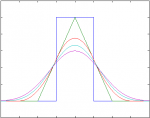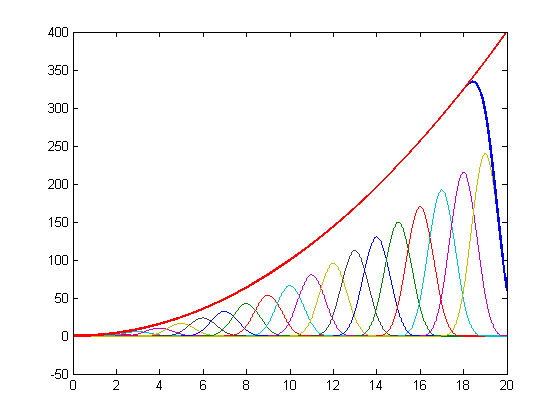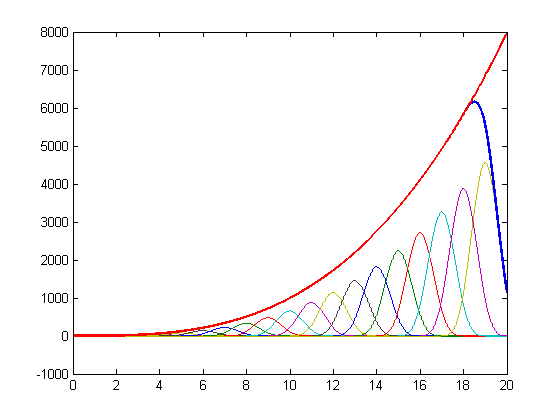|
|
| Zeile 1: |
Zeile 1: |
| | <section begin="head"/> | | <section begin="head"/> |
| | [[Datei:bspline_family.png|right|150px|Family of B-splines up to N=4]] | | [[Datei:bspline_family.png|right|150px|Family of B-splines up to N=4]] |
| − | A B-Spline of order <math>N</math> is known to be able to reproduce any polynomial up to order <math>N</math><ref>I.J. Schoenberg: "Cardinal interpolation and spline functions", ''J. Approx. Theory volume 2'', pp. 167-206, 1969</ref>: | + | A B-Spline of order <math>N</math> is known to be able to reproduce any polynomial up to order <math>N</math>: |
| | | | |
| | <math> | | <math> |
| Zeile 7: |
Zeile 7: |
| | </math> | | </math> |
| | | | |
| − | In words, a proper linear combination of shifted versions of a B-Spline can reproduce any polynomial up to order <math>N</math>. This is needed for different applications, for example, for the Sampling at Finite Rate of Innovation (FRI) framework<ref>P.L. Dragotti, M. Vetterli, T.Blu: "Sampling Moments and Reconstructing Signals of Finite Rate of Innovation: Shannon Meets Strang-Fix", ''IEEE Transactions on Signal Processing'', vol. 55, No. 5, May 2007</ref>. In this case any kernel <math>\varphi</math> reproducing polynomials (that is, satisfying the Strang-Fix conditions) can be used. However, among all possible kernels, the B-Splines have the smallest possible support. | + | In words, a proper linear combination of shifted versions of a B-Spline can reproduce any polynomial up to order <math>N</math>. This is needed for different applications, for example, for the Sampling at Finite Rate of Innovation (FRI) framework. In this case any kernel <math>\varphi</math> reproducing polynomials (that is, satisfying the Strang-Fix conditions) can be used. However, among all possible kernels, the B-Splines have the smallest possible support. |
| | | | |
| | An important question is how to obtain the coefficients <math>c_{m,n}</math> for the reproduction-formula. In this small article, I describe one way. | | An important question is how to obtain the coefficients <math>c_{m,n}</math> for the reproduction-formula. In this small article, I describe one way. |
| Zeile 155: |
Zeile 155: |
| | = References = | | = References = |
| | | | |
| − | <references/> | + | <references> |
| | + | <ref>P.L. Dragotti, M. Vetterli, T.Blu: "Sampling Moments and Reconstructing Signals of Finite Rate of Innovation: Shannon Meets Strang-Fix", ''IEEE Transactions on Signal Processing'', vol. 55, No. 5, May 2007</ref> |
| | + | <ref>I.J. Schoenberg: "Cardinal interpolation and spline functions", ''J. Approx. Theory volume 2'', pp. 167-206, 1969</ref> |
| | + | </references> |
| | | | |
| | = Comments = | | = Comments = |
A B-Spline of order  is known to be able to reproduce any polynomial up to order
is known to be able to reproduce any polynomial up to order  :
:

In words, a proper linear combination of shifted versions of a B-Spline can reproduce any polynomial up to order  . This is needed for different applications, for example, for the Sampling at Finite Rate of Innovation (FRI) framework. In this case any kernel
. This is needed for different applications, for example, for the Sampling at Finite Rate of Innovation (FRI) framework. In this case any kernel  reproducing polynomials (that is, satisfying the Strang-Fix conditions) can be used. However, among all possible kernels, the B-Splines have the smallest possible support.
reproducing polynomials (that is, satisfying the Strang-Fix conditions) can be used. However, among all possible kernels, the B-Splines have the smallest possible support.
An important question is how to obtain the coefficients  for the reproduction-formula. In this small article, I describe one way.
for the reproduction-formula. In this small article, I describe one way.
Starting from

the coefficients can be obtained using the dual of  ,
,  (I set
(I set  for consistency with my notes):
for consistency with my notes):

However, even if the dual would be known, solving the infinite integral is only feasible when the dual has finite support. This is the case with the B-Spline itself but not with its dual!
A closer look at the formula tells that this is nothing more than a convolution (under the assumption that  is symmetric which is the case):
is symmetric which is the case):

Now, this can be transformed to fourier domain:

Writing the inverse of this expression yields:

It is known that[1]:

so that

Now the whole procedure has been reduced to calculate the derivative of  and set the result to zero.
and set the result to zero.
An open question is how to obtain the dual of  . As the reproduction formula spans a vector space, the
. As the reproduction formula spans a vector space, the  must be at least bi-orthogonal to
must be at least bi-orthogonal to  . This translates in fourier domain to[2]:
. This translates in fourier domain to[2]:

The fourier transform of a B-Spline of order  is (e.g. [3]):
is (e.g. [3]):

The following derivation of the sum is borrowed from [4]. For this derivation to work, I set  temprarily:
temprarily:

and because  is always even:
is always even:

Because of the periodicity it is known that

such that

And finally the following relation is used:

in order to finally obtain:

and with  :
:

Therefore, together with  this yields:
this yields:

and finally substituting for  :
:

As this function is not well defined it is better to use the limit:

Examples for a cubic spline
For a cubic spline (N=3) the coefficients are:

References
- ↑ http://en.wikipedia.org/wiki/Dirac_delta_function
- ↑ S. Mallat: "A Wavelet Tour of Signal Processing", Academic Press 1999
- ↑ M.Unser: "Splines - A Perfect Fit for Signal and Imaging Processing", IEEE Signal Processing Magazine Nov. 1999
- ↑ M.J.C.S. Reis, P.J.S.G. Ferreira, S.F.S.P. Soares: "Linear combinations of B-splines as generating functions for signal approximation", Elsevier Digital Signal Processing 15, 2005
Referenzfehler: Das in <references> definierte <ref>-Tag hat kein Namensattribut.
Referenzfehler: Das in <references> definierte <ref>-Tag hat kein Namensattribut.
<comments />
Manu said ...


































Bussi
--Manu 19:47, 19. Jul. 2010 (MSD)